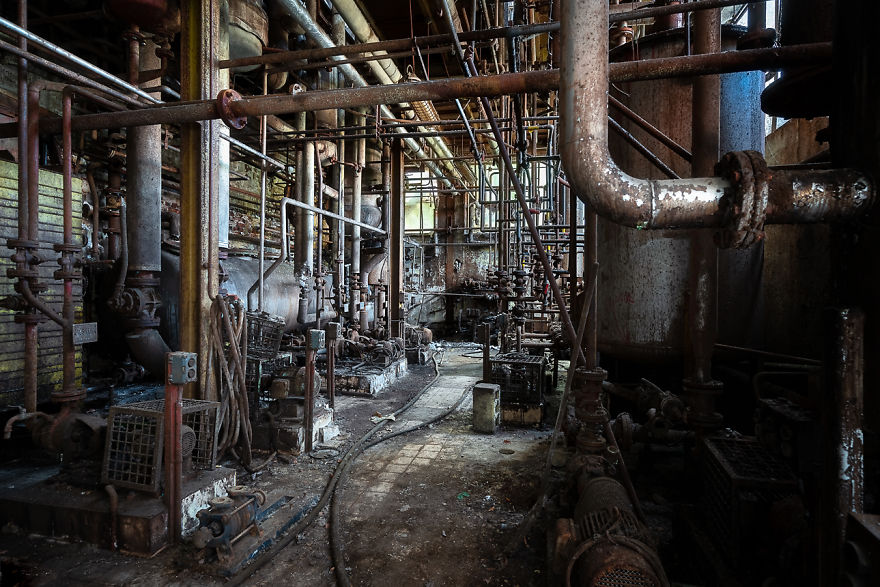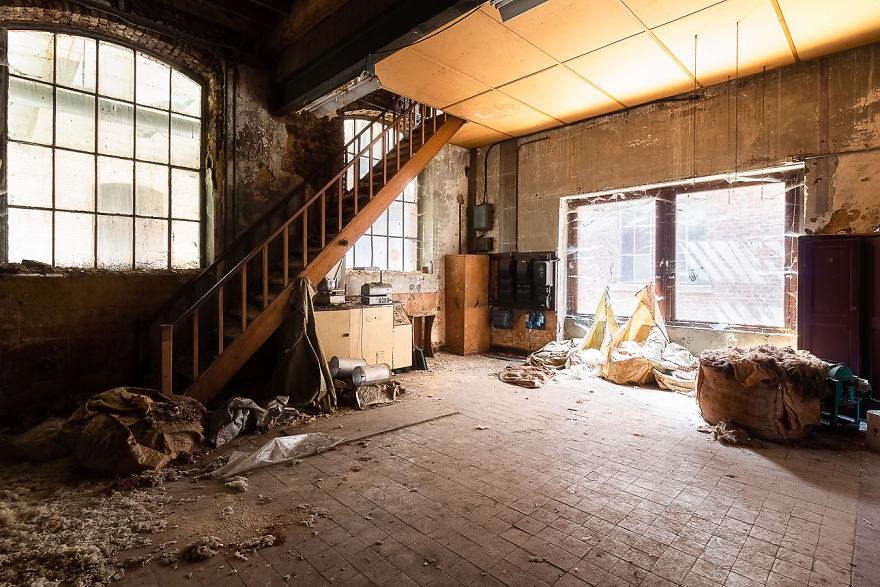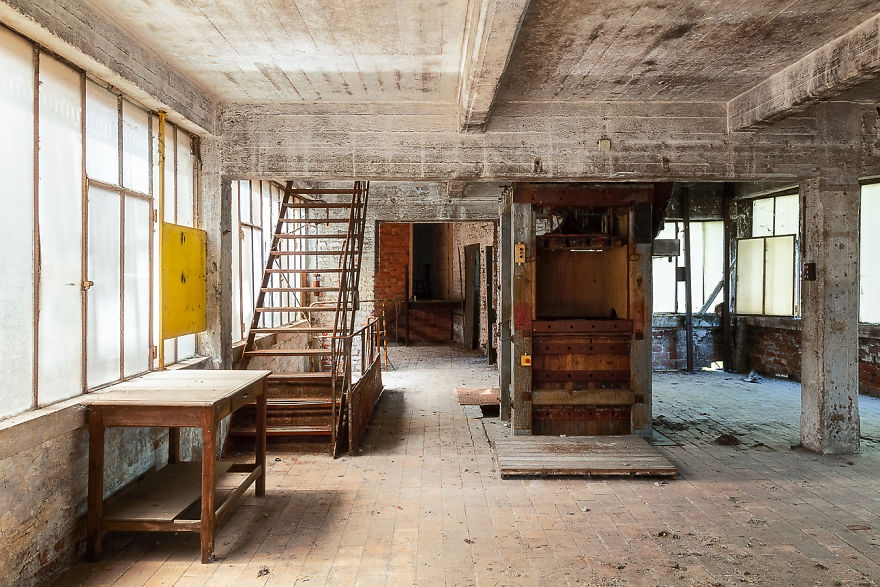At the beginning of the 19th century, an industrial revolution was underway in the area. However, the factories in Verviers did not process coal or iron ore. Instead, they focussed on fabricating wool from sheep. They did this because the rivers in this region contain very pure water without chalk. Next to that, the rivers are slightly acidic making them ideal to treat the wool. The most important river in the area is called Vesder, and Solvent Belge is located right next to it. At first, many small workshops were located along the river. These workshops were later taken over by the much larger factories.
More info: romanrobroek.nl | Facebook | twitter.com | Instagram
Engine Room
The raw material (sheep wool) was brought in by train. Because the water was so pure, the washing process was very efficient and therefore they were able to use rather cheap and low-quality sheep wool from for example Argentina. Unfortunately, the Vesder turned out to become an insufficient water supply to the factories. Especially in the hot summer months. The factories obviously have to rely on a steady supply of water, so this was causing an issue. They decided to build a dam which was mostly paid for by the factories.
Control Room
After the Second World War, it becomes possible to soften water in a cheap way. Therefore it is no longer necessary to use pure and soft water for the process of washing wool. This turnaround causes the location of factories is not required to be near a pure water source. It becomes more viable to transport sheep wool to alternative locations.
Laboratorium
Treadmill
The abandoned lanolin factory Solvent Belge, established on the 2nd of September 1899, used the water from the river Vesder to reduce water consumption in their site. They used the water for their steam engines. The factory used a new process, developed in the United States, to degrease and wash wool. During the washing process, lanolin floats on the water. The lanolin is then drained, filtered, and purified. Lanolin used to be an import part of cosmetics products. You could and still can buy lanolin in cans or bottles. It helps to treat or prevent dry skin, itching, or other skin irritations.
Smiley
The factory closed in 2009. In the meantime, volunteers have been working hard to save and restore multiple original steam engines, with great success. Some of these steam engines were in use until the end of the 20th century. Among other items and machines, the legendary ‘mule jenny‘ is also part of the restored collection.
Offices
Steam pipes
Workshop
Top Floor
Concrete Halls
Machine Room
Staircase to Bags of Wool
Bags of Wool
Equipment
2Kviews
Share on FacebookWould be so cool of this place gets converted to a steampunk cafe or something of that sort.
Latest news I heard is that it's going to be teared down soon.. :(
Load More Replies...In a couple of pics there seems to be a helluva lot of wool going to waste. Also, were all the pipes necessary? I guess they were, but.
My first thoughts, too! How did they know which pipe connects where? And those giants piles of wool that looks already cleaned... what a big waste.
Lanolin still finds plenty of uses, from leather conditioner to rust inhibitors. The bottom of my car is coated in a lanolin-based product.
We can rub our faces to cars and leather couches, it's because sebum is hydrophobic because it's fat. You can pay a teenager to rub his/her face on your car or couch(much sebum, much work), it would be more effective, but really disturbing^^GO GREEN! Or go with a vegetable oil, that make exactly the same "hydrophobic fat effect" but don't use sheep, or money.
Load More Replies...Would be so cool of this place gets converted to a steampunk cafe or something of that sort.
Latest news I heard is that it's going to be teared down soon.. :(
Load More Replies...In a couple of pics there seems to be a helluva lot of wool going to waste. Also, were all the pipes necessary? I guess they were, but.
My first thoughts, too! How did they know which pipe connects where? And those giants piles of wool that looks already cleaned... what a big waste.
Lanolin still finds plenty of uses, from leather conditioner to rust inhibitors. The bottom of my car is coated in a lanolin-based product.
We can rub our faces to cars and leather couches, it's because sebum is hydrophobic because it's fat. You can pay a teenager to rub his/her face on your car or couch(much sebum, much work), it would be more effective, but really disturbing^^GO GREEN! Or go with a vegetable oil, that make exactly the same "hydrophobic fat effect" but don't use sheep, or money.
Load More Replies...
 Dark Mode
Dark Mode 

 No fees, cancel anytime
No fees, cancel anytime 













































































50
12